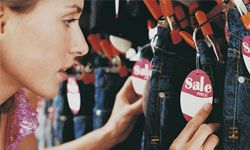The high cost of clothing can be staggering, whether you're seeking out the latest trends or looking for more classic, functional styles. No matter where you're shopping, from specialty stores in your local mall or the chicest boutique in town, you'll find designer jeans priced at $300, handbags made in Italy starting at more than $1,000, and wool pants priced anywhere from $35 to $500. The endless variety is enough to make your head spin and put a serious strain on your wallet.
So what's a frugal fashionista to do? To help make your clothing budget go a little farther, it helps to know how the fashion industry works and gain some insight into retail pricing practices.
Advertisement
Normally, retailers (like Nordstrom, Ann Taylor, Intermix and the Gap) who sell to consumers purchase their goods from a manufacturer or distributor at a wholesale price that includes the cost of designing, manufacturing, and marketing, plus a reasonable profit. These manufacturers and distributors offer products spanning a huge spectrum of quality, materials, and promotion, from mass manufacturers like Liz Claiborne to luxury designer goods companies like LVMH (the company that makes Louis Vuitton apparel). Many goods feature a "Manufacturer's Suggested Retail Price" that serves to present uniform pricing in the marketplace and build in an attractive margin for the retailer. The typical retail markup on fashion items ranges from 2.2 to 2.6 times their wholesale cost [source: Binkley].
Thankfully, the Internet has made shopping for bargains easier than ever. You can shop and compare prices at your favorite department store, retail chain, boutique or specialty store, even buy from trendy designers like Rebecca Taylor and Tory Burch. Grab a bargain at flash sale Web sites such as Ideeli and RueLaLa, or take your time checking out your favorite designers at Outnet or Bluefly. Shopstyle and ShopItToMe let you track your favorite brands and sizes, and send you emails when styles you might be interested in go on sale.
But why is it that you can pay more than $275 for a cashmere sweater at Neiman Marcus -- or bag a deal at Yoox for $120? Read on to learn more about how retail markups (and markdowns) are determined.
Advertisement




